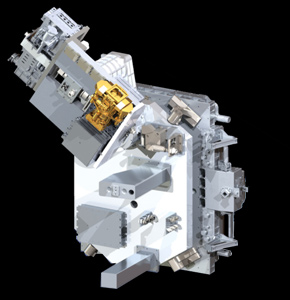Thank you very much for visiting Gunter's Space Page. I hope that this site is useful and informative for you.
If you appreciate the information provided on this site, please consider supporting my work by making a simple and secure donation via PayPal. Please help to run the website and keep everything free of charge. Thank you very much.
TSIS 1

TSIS 1 [NASA/LASP]
The TSIS 1 (Total and Spectral Solar Irradiance Sensor 1) is an instrument on the International Space Station (ISS) to measure the total and spectral solar irradiance.
TSIS is a project of NASA/GSFC (Goddard Space Flight Center) and the University of Colorado CU/LASP (Laboratory for Atmospheric and Space Physics).
The objective of TSIS is to acquire measurements of total and spectral solar irradiance (TSI and SSI, respectively). TSI (Total Solar Irradiance) is required for establishing Earth's total energy input while SSI (Solar Spectral Irradiance) is needed to understand how the atmosphere responds to changes in the sun's output. Solar irradiance is one of the longest and most fundamental of all climate data records derived from space-based observations.
The TSIS instrument was originally built for the cancelled NPOESS satellites. It was then moved to the SIDAR (JPSS Free Flyer 1) freeflying satellite, which was also cancelled. Finally it was reconfigured as an ISS attached payload. It provides continuation of the TIM (Total Irradiance Monitor) and the SIM (Spectral Irradiance Monitor) on NASA’s SORCE satellite launched in 2003 and on the failed Glory satellite in 2011. In 2012, a plan to maintain continuity of the TSI calibration scale between SORCE and TSIS was rapidly implemented through the USAF Space Test Program STPSat-3 that launched in late 2013 an carries the TCTE (TSI Calibration Transfer Experiment).
TSIS 1 was transported in the unpressurized trunk of a Dragon cargo craft to the ISS, where it was mounted on the ELC 3 carrier.
The TSIS 2 will be a free flying satellite.
| Nation: | USA |
|---|---|
| Type / Application: | Earth Science |
| Operator: | NASA GSFC, University of Colorado CU/LASP (Laboratory for Atmospheric and Space Physics) |
| Contractors: | NASA GSFC, University of Colorado CU/LASP (Laboratory for Atmospheric and Space Physics) |
| Equipment: | TSIS |
| Configuration: | Attached ISS payload |
| Propulsion: | None |
| Power: | Via ISS |
| Lifetime: | 5 years |
| Mass: | |
| Orbit: | 400 km × 400 km, 51.6° (typical) |
| Satellite | COSPAR | Date | LS | Launch Vehicle | Remarks | |
|---|---|---|---|---|---|---|
| TSIS 1 | N/A | 15.12.2017 | CC SLC-40 | Falcon-9 v1.2 | with Dragon CRS-13, SDS |
References:
Further ISS missions: ISS complex
|
